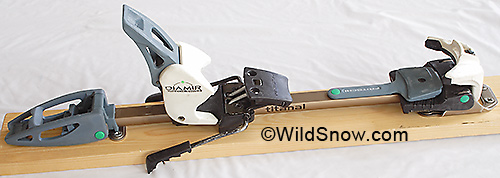
Complete Fritschi Diamir Titanal binding. The design revolution with this binding was in using a single lightweight rail to connect heel and toe units. This rail was ostensibly made from Titanal, a very strong aluminum alloy. Nonetheless the rail bent too easily and was strengthened in later models. In all, the binding was very lightweight and had a modern look and feel. Click to enlarge.
Fritschi Diamir Titanal was Fritschi’s second offering in the binding market, and was a major and long overdue upgrade from their first effort, the FT88 (see binding museum index for FT88). The binding was distributed by Black Diamond Equipment beginning in 1995, and hailed as the first modern ski touring randonneee binding that made an effort to match alpine bindings in downhill performance, as well as being quite light in weight.
According to some accounts, the family tree of Fritschi bindings has roots in the Gertsch (though we are not clear during which date range this occurred). The story is that Gertsch jobbed out their parts manufacturing to a Swiss company, Fritschi, that made precision drawing tables. This prompted Fritschi to enter the ski binding business themselves using ideas they’d developed while producing the Gertsch. Examination of Fritschi’s first binding, the FT88 (circa 1982), reveals many similarities between it and the earlier Gertsch, thus this story is perhaps fact. (source: Alpenglow.org ).
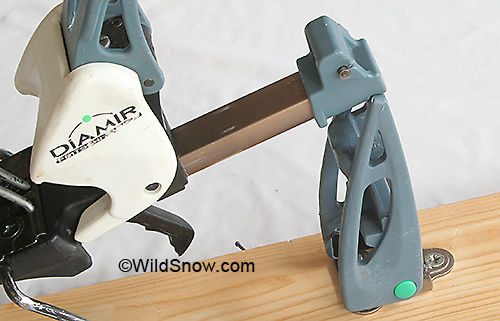
A somewhat leading feature of the Titanal was a four position heel elevator with a very high top lift. The lever is easy to operate with a ski pole, and the minimalist design contributes to the binding’s light weight. The binding can be identified by its white plastic parts, which would change to dark blue on the next model.
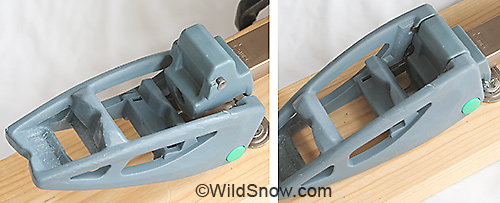
Heel latch/elevator detail. Unlatched position shown to left provides a nice heel-flat-on-ski mode that’s good for touring low angled terrain. Photo to left shows the unit in latched position ready for downhill skiing.
The end of the rail slides freely forward and back in the heel unit (see photo above), thus allowing the ski to flex. Only problem with this system is that with a soft ski the unit could become unlatched, resulting in a well known Fritschi problem that came to be called “insta-tele.” This problem persisted in all Fritschi binding models until the Freeride Plus was released in 2006.
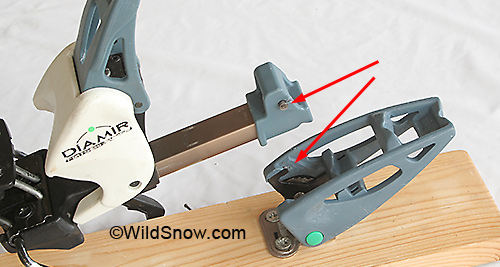
To engage in alpine mode, you simply drop the rear of the plate down into the latch, then pull the latch up. This engages the arrow indicated pin with associated slot.
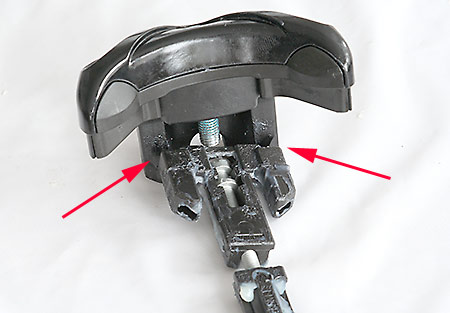
One thing that made the Titanal so light was how Fritschi minimized and built the toe release mechanism into a small area under the toe wings. As the wings rotate, they push a shoulder against a spring loaded piston hidden in the binding rail/plate, in turn allowing side release. Details of this can be seen in our Fritschi frame binding parts breakdown. (Toe unit shown above is from late model Fritschi).
While the Diamir was revolutionary in that it had most of the function of its contemporary alpine bindings and looked the part, as a first generation model it was not without problems. Perhaps the worst of these was that the bar connection toe and heel was weak, and bent with heavy use. This was corrected in the next model, Titanal II. Another problem was that with flexible skis or aggressive use, the mode latch at the heel could inadvertently release in downhill mode, leading to a condition that came to be known as “insta-tele.” This problem wasn’t totally taken care of until 2005, when Fritschi changed the mode latch in all models.
Weight (one binding with brake and screws): 32.3 oz, 918 gr
Thanks goes to Boone Caudill for donating these bindings to the WildSnow collection.
First Couloir Magazine review of Diamir was in volume VIII-1, Oct/Nov 1995.

